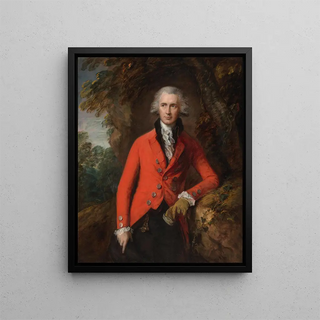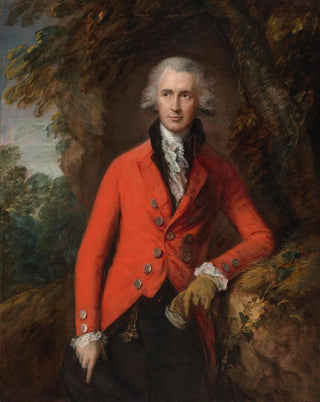Art print | M. Thomas Hibbert - Thomas Gainsborough


View from behind

Frame (optional)
Thomas Gainsborough's "M. Thomas Hibbert" is an iconic artwork that embodies the elegance and finesse of the 18th century. This portrait, rich in visual detail, immerses us in the refined world of English aristocracy of the time. Through the delicate features of its subject, Gainsborough succeeds in capturing not only the external appearance of M. Hibbert but also a deeper essence—a vibrant personality that seems to transcend time. Light, color, and texture intertwine to create an atmosphere that is both intimate and majestic, inviting the viewer to immerse themselves in this frozen moment.
**Style and uniqueness of the work**
Gainsborough's style is distinguished by its ability to blend realism and romanticism. In "M. Thomas Hibbert," the artist employs a subtle color palette, where shades of blue and green harmoniously mingle to evoke emotional depth. The brushstrokes, both fluid and precise, bring life to the texture of the clothing and the softness of the skin. This art print does not merely depict a man; it tells a story—one of an era where appearance reflected social stature. M. Hibbert's posture, slightly turned, suggests introspection, while his frank and direct gaze engages the viewer in a silent dialogue. This duality between appearance and being, between public and private, gives the work a timeless dimension.
**The artist and his influence**
Thomas Gainsborough, one of the masters of portrait and landscape art, left a lasting mark on art history with his ability to capture the human soul. His work, influenced by great masters of the past such as Van Dyck and Rembrandt, stands out for its unique approach that combines sensitivity and technical virtuosity. Gainsborough reinvented the art print by integrating elements of nature, creating a visual harmony that transcends mere representation. His influence endures, inspiring many contemporary artists who seek to explore the relationship between the individual and their environment. Through works like "M. Thomas Hibbert," Gainsborough reminds us

Matte finish

View from behind

Frame (optional)
Thomas Gainsborough's "M. Thomas Hibbert" is an iconic artwork that embodies the elegance and finesse of the 18th century. This portrait, rich in visual detail, immerses us in the refined world of English aristocracy of the time. Through the delicate features of its subject, Gainsborough succeeds in capturing not only the external appearance of M. Hibbert but also a deeper essence—a vibrant personality that seems to transcend time. Light, color, and texture intertwine to create an atmosphere that is both intimate and majestic, inviting the viewer to immerse themselves in this frozen moment.
**Style and uniqueness of the work**
Gainsborough's style is distinguished by its ability to blend realism and romanticism. In "M. Thomas Hibbert," the artist employs a subtle color palette, where shades of blue and green harmoniously mingle to evoke emotional depth. The brushstrokes, both fluid and precise, bring life to the texture of the clothing and the softness of the skin. This art print does not merely depict a man; it tells a story—one of an era where appearance reflected social stature. M. Hibbert's posture, slightly turned, suggests introspection, while his frank and direct gaze engages the viewer in a silent dialogue. This duality between appearance and being, between public and private, gives the work a timeless dimension.
**The artist and his influence**
Thomas Gainsborough, one of the masters of portrait and landscape art, left a lasting mark on art history with his ability to capture the human soul. His work, influenced by great masters of the past such as Van Dyck and Rembrandt, stands out for its unique approach that combines sensitivity and technical virtuosity. Gainsborough reinvented the art print by integrating elements of nature, creating a visual harmony that transcends mere representation. His influence endures, inspiring many contemporary artists who seek to explore the relationship between the individual and their environment. Through works like "M. Thomas Hibbert," Gainsborough reminds us






